15 Best Spots for Surfing in Texas to Catch Best Waves

If you are a surfing enthusiast in the Lone Star State, you have come to the right place! From the iconic shores of South Padre Island to the hidden coves of the Coastal Bend, we have scoured the state to bring you the most coveted surf destinations. Whether you’re a seasoned pro or a newcomer to the art of wave riding, these spots cater to surfers of all skill levels, promising unforgettable sessions and pristine conditions. This guide unveils the 15 best spots for surfing in Texas, where you can catch the most epic waves and elevate your surfing experience to new heights.
Surfing in Texas: What Sets it Apart
While the surf in Texas may not be as consistent or powerful as some of the world’s famous surfing meccas, this coastal state harbors a unique charm that sets it apart from the rest. This section will explain why surfing in Texas a truly one-of-a-kind experience for any adventurous surfer.
The Wave Seasons in Texas
Spring is the prime time for surfing in Texas, as it offers the opportunity to catch the tail end of the winter swells while also welcoming the beginning of the summer swell season. If you’re planning a surf trip to Texas, this is the ideal time to increase your chances of scoring some quality waves.
However, it’s important to note that for the majority of the year, the waves in Texas tend to be relatively choppy and inconsistent. This doesn’t mean that the waves are “unsurfable”, but surfing in Texas does require surfers to put in extra effort and patience. The summer and fall hurricane swells can sometimes deliver more powerful and challenging waves that will truly put your skills to the test.
The Unique Surf Culture of Texas
Surfing in Texas is a special experience because the surf culture is not the primary driving force behind the coastal cities. Instead, you’ll find a unique blend of Western town charm and surf city vibes, creating an entertaining and welcoming environment that is truly one-of-a-kind.
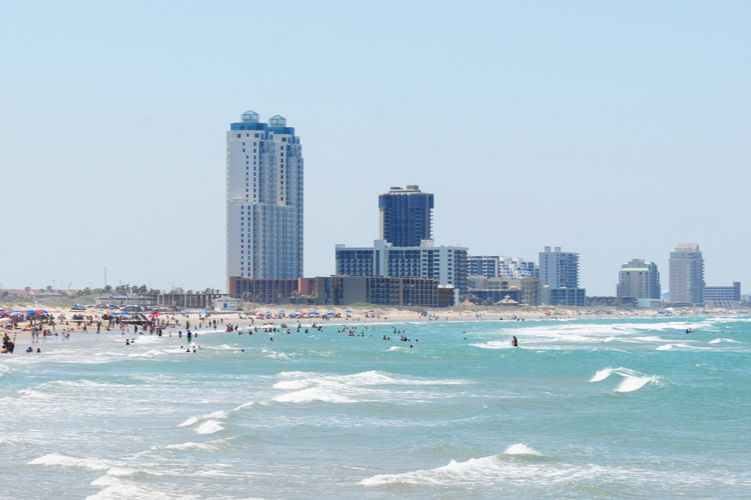
Essential Gear for Surfing in Texas
The water temperatures in Texas can vary greatly throughout the year, ranging from 59°F – 87°F (15°C – 30.5°C). During the winter months, it’s essential to have a full wetsuit to stay warm, while in the summer, board shorts will suffice. Don’t forget to pack reef-safe sunscreen as well, as the Texas sun can be intense and cause dangerous sunburns if you’re not properly protected.
By understanding the wave conditions, embracing the unique surf culture, and being prepared with the right gear, you’ll be well-equipped to make the most of your surfing adventures in Texas.
The Top 15 Surf Spots in Texas
With our insider tips and expert recommendations in this section, you will be riding the best places to surf in Texas. Below are the top surfing locations in the Lone Star State:
1. Galveston Island
Nestled off the Houston coastline, Galveston Island stands as Texas’ northernmost surfing gem. If you’ve caught Dana Brown’s iconic film “Step Into Liquid”, you may recall surfers fearlessly riding the towering wakes of massive supertankers in the Galveston Shipping Channel.

Remarkably, this exhilarating experience is no mere cinematic fantasy – it’s a reality that daring Texan wave riders can pursue. While accessing these colossal shipping channel swells requires permits and comes at a premium, the reward is an adrenaline-pumping ride unlike any other. Beyond this unique thrill, surfing in Texas Galveston offers a diverse surfing playground, from mellow rollers suited for beginners to challenging swells testing seasoned surfers’ skills.
- Water: Gulf of Mexico
- Swell & Wind: Swells are typically small and wind-driven. The best conditions are with southerly winds.
- Water Temperature: Ranges from mid-60s°F in winter to mid-80s°F in summer.
- Air Temperature: Mild winters (50s-60s°F) and hot, humid summers (80s-90s°F).
- Wave Size: Typically 1-3 feet, but can get up to 6 feet on occasion.
- Crowd Levels: Moderate, especially on weekends and holidays.
- Best Time to Surf: Spring and fall when winds are favorable and crowds are smaller.
- Launch points: East Beach, Galveston Island State Park, and Bolivar Peninsula.
- Unique feature: Surfing the wakes of large ships in the Galveston Shipping Channel (requires experienced surfers and a permit).
- Skills: Intermediate to advanced for shipping channel, beginner to intermediate for beach breaks.
- How long to get there: 1 hour from Houston, 4 hours from Dallas, 5 hours from Austin
2. Surfside Beach
When it comes to the best places to surf in Texas, Surfside Beach stands out as a prime destination for wave riders. Surfside Beach boasts iconic surf spots like the Quintana Jetty and the 61st Street Pier, including the notorious “Assholes”, named for the local homeowners’ contentious relationship with surfers.
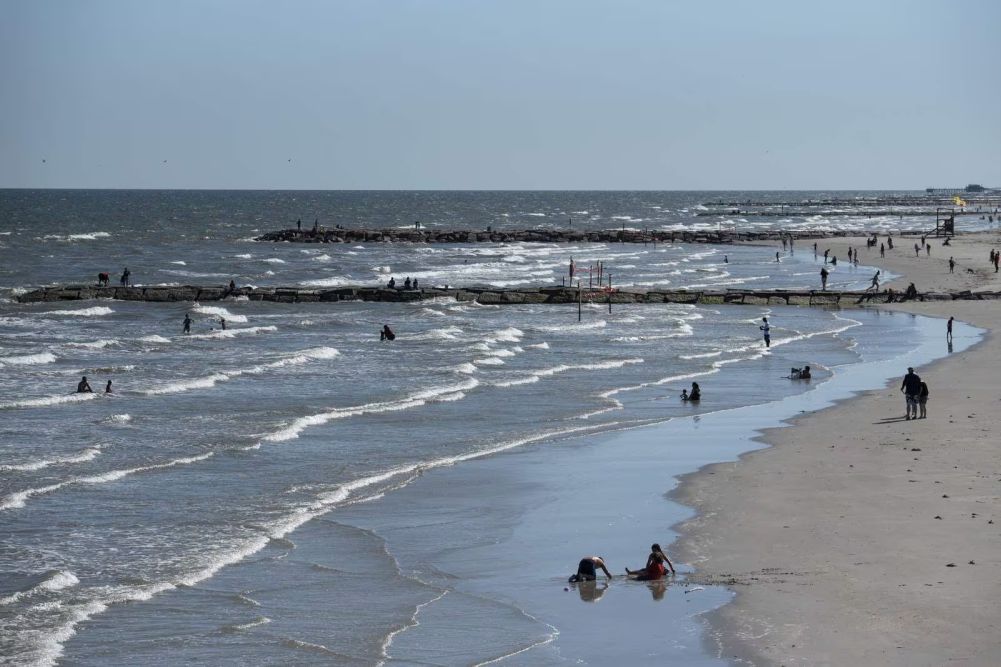
While Galveston’s surf might be mushy, and the water quality less than pristine, the allure of Surfside Beach lies in its consistent waves and the vibrant surfing community that gathers along its shores.
- Water: Gulf of Mexico
- Swell & Wind: Consistent groundswells, offshore winds create clean conditions
- Water Temperature: 65-85°F (18-29°C)
- Air Temperature: 60-90°F (15-32°C)
- Wave Size: Knee to chest high, occasional overhead sets
- Crowd Levels: Moderately crowded, especially on weekends and holidays
- Best Time to Surf: Early mornings, weekdays for fewer crowds
- Unique Feature: The break known as “Assholes”
- Skills: Suitable for beginners to intermediate surfers
- How Long to Get There: 1 hour from Houston, 4.5 hours from Dallas, 5 hours from Austin
3. Matagorda
Can you surf in Texas? Matagorda proves it’s possible. Nestled between the surfing hotspots of Galveston and Port Aransas, Matagorda is considered a true “locals only” spot. What sets Matagorda apart is its deep ocean floor that rapidly ascends to sandbars, creating ideal conditions for strong waves.
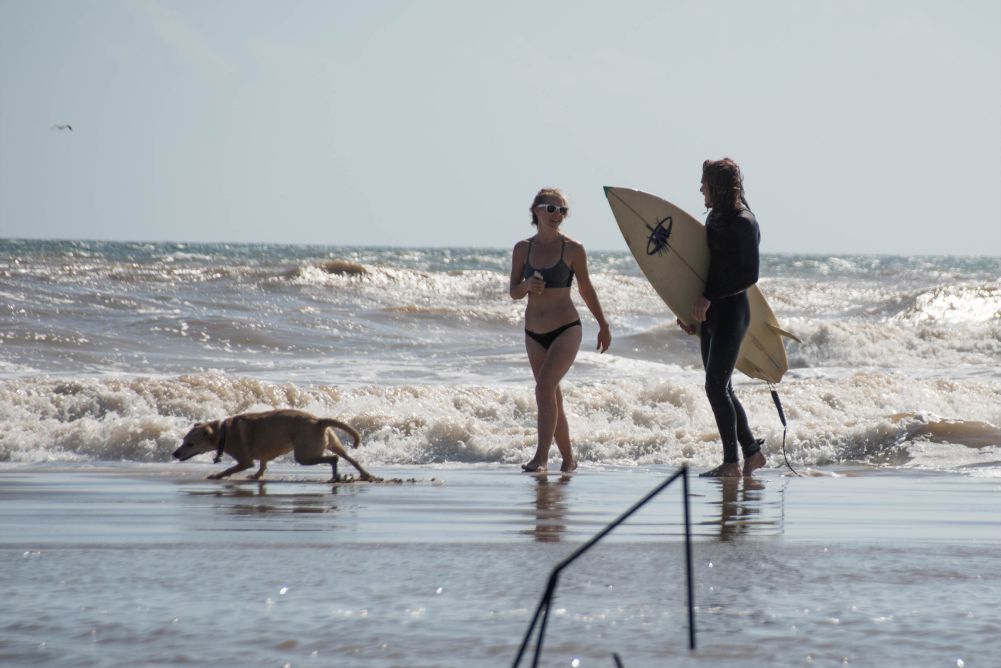
Here, surfers can expect to encounter river mouth waves with both right and left swell directions with the wavelength ranges from 50 to 150 meters. While the local surf community may fiercely guard this spot, it serves as a testament to the fact that, yes, you can indeed surf in Texas – and Matagorda is living proof of the state’s untapped surf potential.
- Water: Gulf of Mexico
- Swell & Wind: Consistent groundswells, offshore winds create clean conditions
- Water Temperature: 65-85°F (18-29°C)
- Air Temperature: 60-90°F (15-32°C)
- Wave Size: Chest to overhead
- Crowd Levels: Uncrowded, mostly locals
- Best Time to Surf: Early mornings, mid to high tide
- Unique Feature: Rivermouth waves, rapid depth changes
- Skills: Intermediate to advanced
- How Long to Get There: 1.5 hours from Houston, 5 hours from Dallas, 5.5 hours from Austin
4. Corpus Christi
Corpus Christi offers a plethora of surf spots, with the Fish Pass Jetties being a standout spot for surfing in Texas. These jetties provide protection from currents in nearly any swell direction, offering fast takeoffs and excellent wave shapes.
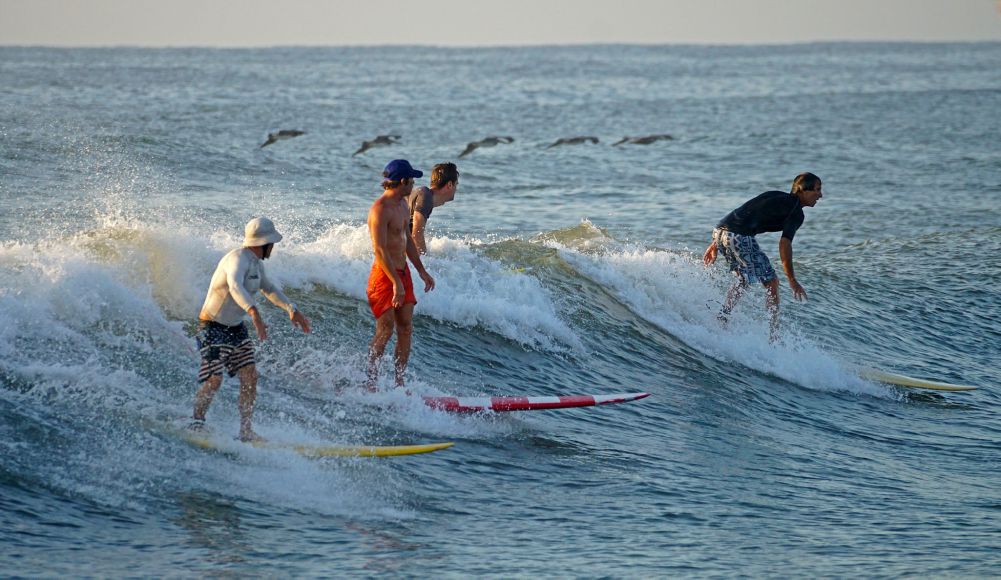
Regardless of the tide, decent swells are produced, with waves reaching lengths of 150 to 300 meters on good days.
- Water: Gulf of Mexico
- Swell & Wind: Consistent swells, offshore winds create clean conditions
- Water Temperature: 65-85°F (18-29°C)
- Air Temperature: 60-95°F (15-35°C)
- Wave Size: Waist to overhead
- Crowd Levels: Moderately crowded, especially on weekends and holidays
- Best Time to Surf: Early mornings, weekdays for fewer crowds
- Launch Points: Public beaches, jetties
- Access: Public beaches, paid parking at some areas
- Unique Feature: Fish Pass Jetties offer protection and great wave shape
- Skills: Suitable for intermediate to advanced surfers
- How Long to Get There: 3.5 hours from Houston, 6 hours from Dallas, 4 hours from Austin
5. Boca Chica
Boca Chica is a surfer’s paradise, offering some of the best surfing in Texas with its super long lefts and excellent glassiness. When the north winds blow, this location truly shines, delivering barreling waves that are a common sight.
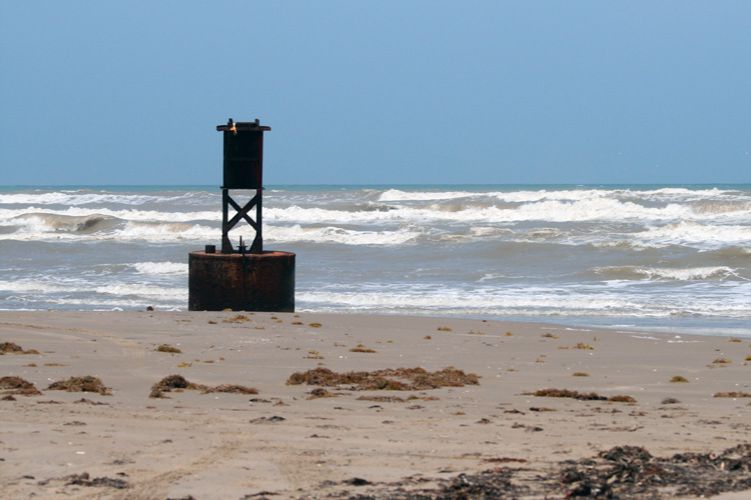
Whether you’re chasing breakwater or jetty waves, Boca Chica delivers powerful, long rides ranging from 150 to 300 meters. Despite its world-class waves, the beach remains pleasantly uncrowded, with a mellow vibe. However, caution is advised as serious rips, undertow, and the occasional shark can make an appearance, so keeping your eyes peeled is a must while catching these epic waves.
- Water: Gulf of Mexico
- Swell & Wind: North winds create best swells, offshore winds create clean conditions
- Water TempeAir Temperature: rature: 65-85°F (18-29°C)
- 60-95°F (15-35°C)
- Wave Size: Overhead to double overhead
- Crowd Levels: Uncrowded, mostly locals
- Best Time to Surf: Early mornings, north wind swells
- Access: Public beaches
- Amenities: Limited amenities nearby
- Unique Feature: Long, barreling left-handers
- Skills: Intermediate to advanced
- How Long to Get There: 5 hours from Houston, 7.5 hours from Dallas, 6 hours from Austin
6. Jamaica Beach
Not far from Galveston lies Jamaica Beach, a prime location for some of the best surfing in Texas. Here, ripping waves and the occasional tubing opportunity await the adventurous surfer.
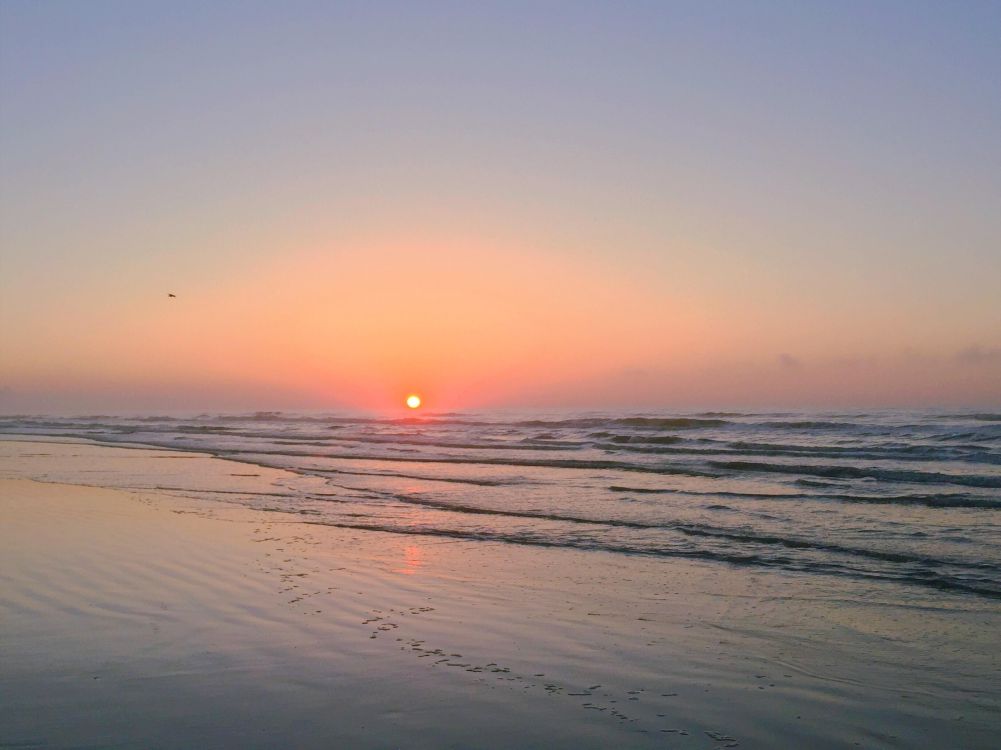
With a sandy bottom and beach-break waves, Jamaica Beach delivers swells from both the right and left, catering to a variety of riding styles. All tides provide excellent surf conditions, with hollow, fast, and fun waves that will leave you craving more.
- Water: Gulf of Mexico
- Swell & Wind: Consistent groundswells, offshore winds create clean conditions
- Water Temperature: 65-85°F (18-29°C)
- Air Temperature: 60-90°F (15-32°C)
- Wave Size: Chest to overhead
- Crowd Levels: Moderately crowded, especially on weekends and holidays
- Best Time to Surf: Early mornings, weekdays for fewer crowds
- Launch Points: Public beach access points
- Unique Feature: Hollow, fast waves
- Skills: Suitable for intermediate to advanced surfers
- How Long to Get There: 1 hour from Houston, 4 hours from Dallas, 4.5 hours from Austin
7. South Padre Island
South Padre Island is a beloved place to surf in Texas for savvy wave riders, offering unique waves that set it apart as one of the best surfing destinations in the state. Thanks to the continental shelf’s steep drop, surfers can enjoy a diverse range of beach-break waves, from long to short, with swell directions from both left and right.

This unique combination creates a surfer’s paradise, where every session promises a fresh and exhilarating experience.
- Water: Gulf of Mexico
- Swell & Wind: Consistent swells, offshore winds create clean conditions
- Water Temperature: 65-85°F (18-29°C)
- Air Temperature: 60-95°F (15-35°C)
- Wave Size: Waist to overhead
- Crowd Levels: Moderately crowded, especially during spring break
- Best Time to Surf: Early mornings, weekdays for fewer crowds
- Unique Feature: Long and short beach breaks, both left and right breaks
- Skills: Suitable for beginner to advanced surfers
- How Long to Get There: 6 hours from Houston, 8.5 hours from Dallas, 7 hours from Austin
8. Quintana
When seeking out the best surfing in Texas, Quintana is a spot that shines when the waves get too big at the more famous Surfside beach. This stretch of coastline offers up a great mix of both left and right-hand waves that pack some serious speed and power, making for an exhilarating surf experience.

The optimal wind directions for scoring quality waves at Quintana are from the northwest, west, and southwest quadrants. Remarkably, the waves here stay rideable at all tides, whether it’s low, mid, or high.
So when big swells start pounding other Texas beaches, savvy surfers make a beeline for Quintana to capitalize on its high-quality, high-velocity waves from multiple peak sources. It’s performances like these that cement Quintana’s reputation as one of the premier surfing destinations in the Lone Star State.
- Water: Gulf of Mexico
- Swell & Wind: Consistent groundswells, offshore winds from NW, W, SW create clean conditions
- Water Temperature: 65-85°F (18-29°C)
- Air Temperature: 60-90°F (15-32°C)
- Wave Size: Overhead to double overhead
- Crowd Levels: Moderately crowded, especially on weekends and holidays
- Best Time to Surf: Early mornings, weekdays for fewer crowds
- Unique Feature: Fast, powerful waves
- Skills: Intermediate to advanced
- How Long to Get There: 1 hour from Houston, 4.5 hours from Dallas, 5 hours from Austin.
9. Mansfield Jetty
Is there surfing in Texas? Absolutely! One excellent but remote surf destination in the state is Mansfield Jetty. To access this secluded spot, you’ll need a four-wheel drive vehicle and camping gear, as it’s an undeveloped beach area.
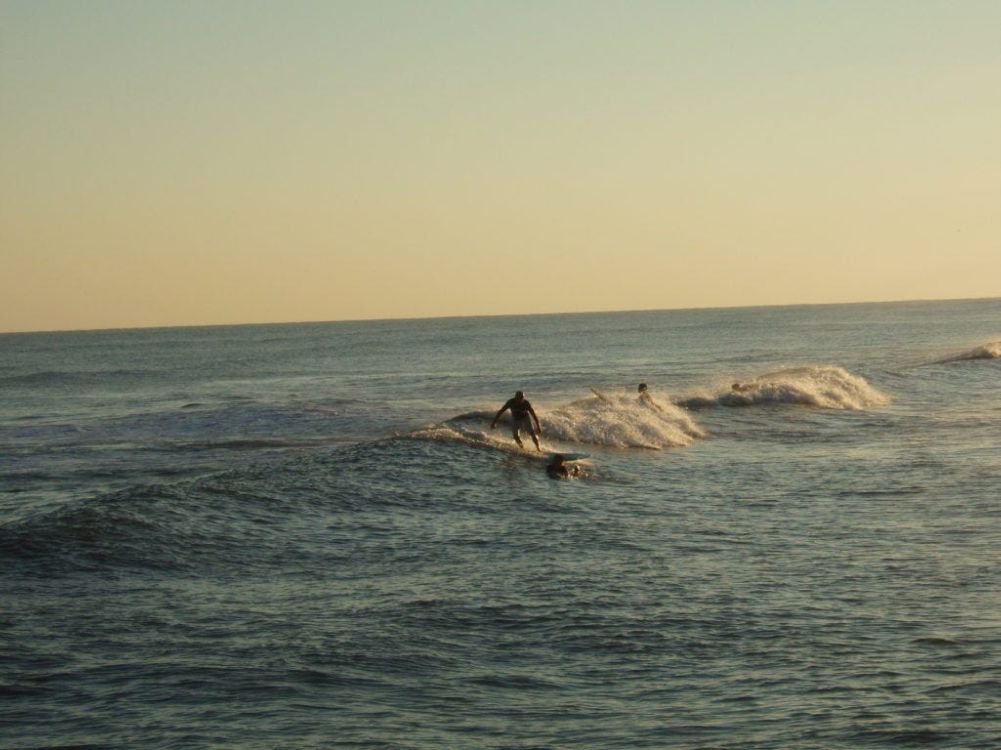
However, Mansfield Jetty offers consistent beach break waves that peel from both the left and right. The waves tend to have a good frequency, though caution is advised due to potential rip currents, rocky areas, and the occasional shark sighting. But with likely very few others around, you’ll have this pristine surfing spot largely to yourself if you don’t mind the remoteness. So for adventurous Texas surfers, Mansfield Jetty provides a fantastic offshore wave with a distinctly untamed vibe.
- Water: Gulf of Mexico
- Swell & Wind: Receives swells from Gulf and prevailing winds from southeast
- Water Temperature: Mid 70s°F to mid 80s°F
- Air Temperature: 70s°F to 90s°F
- Wave Size: 2-4 ft typical, can get larger on north winds
- Crowd Levels: Moderate
- Best Time to Surf: Late summer/early fall for smallest crowds and warm water
- Access: Free public parking lot off FM 3005
- Amenities: None
- Unique Feature: Jetty provides some shelter and can shape waves
- Skills: Beginner to intermediate
- How Long to Get There: 1 hour from Houston
10. Bob Hall Pier
Where to surf in Texas? One excellent option is Bob Hall Pier, located just across the JFK Causeway from Corpus Christi in Padre Balli Beach Park. This spot is known for offering faster, more barreling waves compared to other areas in the region, making it an ideal playground for shortboarders.
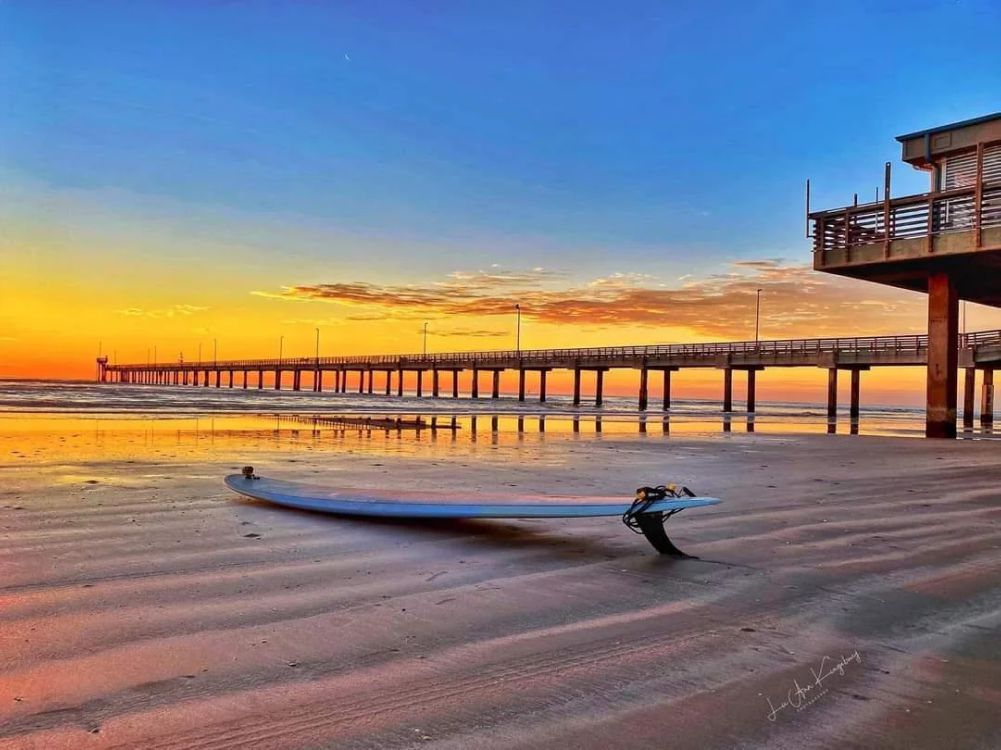
Surfers can expect to find both lefts and rights peeling off the beach break at Bob Hall Pier. The waves here have a zippy, hollow character that allows you to really open up and showcase your high-performance surfing skills. While the wave shape may not always be perfect, the quality wavefronts provide a fun challenge for more experienced Texas surfers looking to go for broke.
- Water: Gulf of Mexico
- Swell & Wind: Gulf swells, easterly winds
- Water Temperature: 70s°F to mid 80s°F
- Air Temperature: 70s°F to 90s°F
- Wave Size: 2-4 ft typical
- Crowd Levels: Heavy on summer weekends
- Best Time to Surf: Fall for smaller crowds
- Launch Points: Beach on north side of pier
- Unique Feature: Fishing pier shapes some waves
- Skills: All levels
- How Long to Get There: 3.5 hours from Houston
11. Port Aransas
Port Aransas, or Port A as locals call it, is a prime places for surfing in Texas right next door to Corpus Christi. The chest-deep water and slow waves make it an ideal spot for parents to send kids to surf schools during summer months.
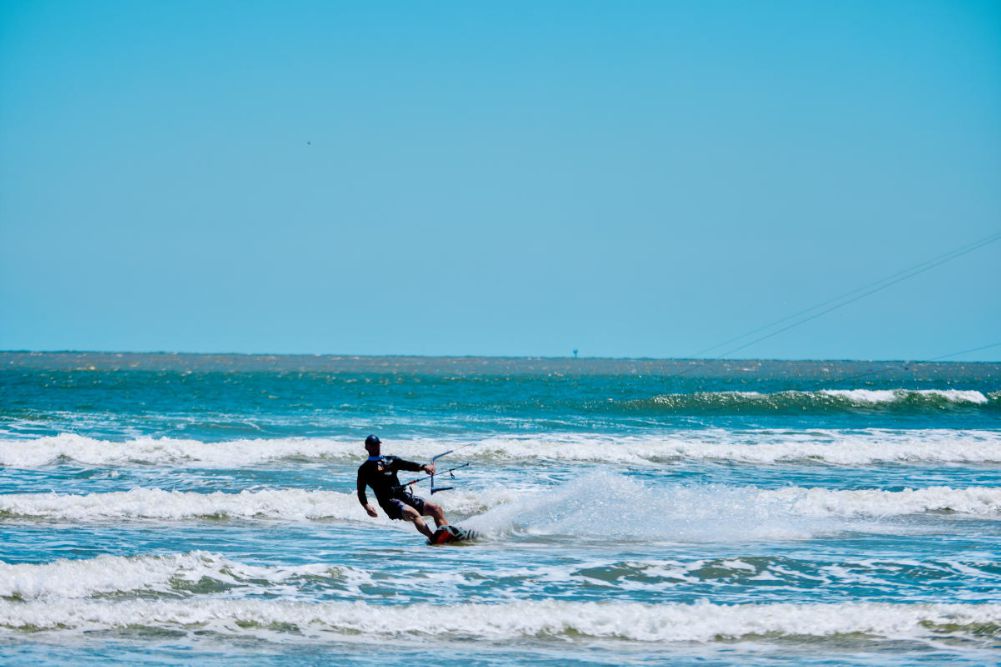
The Horace Caldwell Pier is a regional hotspot known for softer waves, perfect for surfers of all experience levels. Alternatively, a 10-minute ferry ride takes you to San Jose Island, offering smaller waves and uncrowded beaches, great for beginners and a relaxing getaway.
- Water: Gulf of Mexico
- Swell & Wind: Gulf swells, variable winds
- Water Temperature: 60s°F in winter, 80s°F in summer
- Air Temperature: 50s°F to 90s°F
- Wave Size: 2-5 ft typical, can get larger swells
- Crowd Levels: Heavy in summer
- Best Time to Surf: Spring and fall for best combination of waves and smaller crowds
- Unique Feature: Can be very consistent beachbreak
- Skills: All levels
- How Long to Get There: 4 hours from Houston
12. Horace Caldwell Pier
When it comes to the best surfing in Texas, Horace Caldwell Pier ranks highly as a regional favorite thanks to its friendly vibe and reliable wave quality.

This spot is known for producing nice shapely waves that break off the left side of the pier, offering a faster, more robust shape compared to the right. While not necessarily huge in size, these peaky waves provide incredibly fun rides, especially on an outgoing tide when they stand up nicely. The waves cater to varying skill levels, surfers of all abilities – from total beginners to seasoned pros – can have an enjoyable session here.
- Water: Gulf of Mexico
- Swell & Wind: Gulf swells, predominant southeasterly winds
- Water Temperature: Mid 60s°F to mid 80s°F
- Air Temperature: 60s°F to 90s°F
- Wave Size: 2 – 4 ft typical
- Crowd Levels: Moderate to heavy
- Best Time to Surf: Fall and winter for smaller crowds
- Unique Feature: Pier can shape some waves
- Skills: Beginner to advanced
- How Long to Get There: 1 hour from Houston
With its uncrowded nature, user-friendly waves, and dependable surf conditions, it’s no wonder Horace Caldwell Pier emerges as one of the top surfing locations for wave riders across Texas.
13. North Jetty
For those wondering if there surf in Texas, North Jetty answers that question with an emphatic “yes” time and again. Many consider this to be the best spot along the entire Texas coast for scoring high-quality waves.
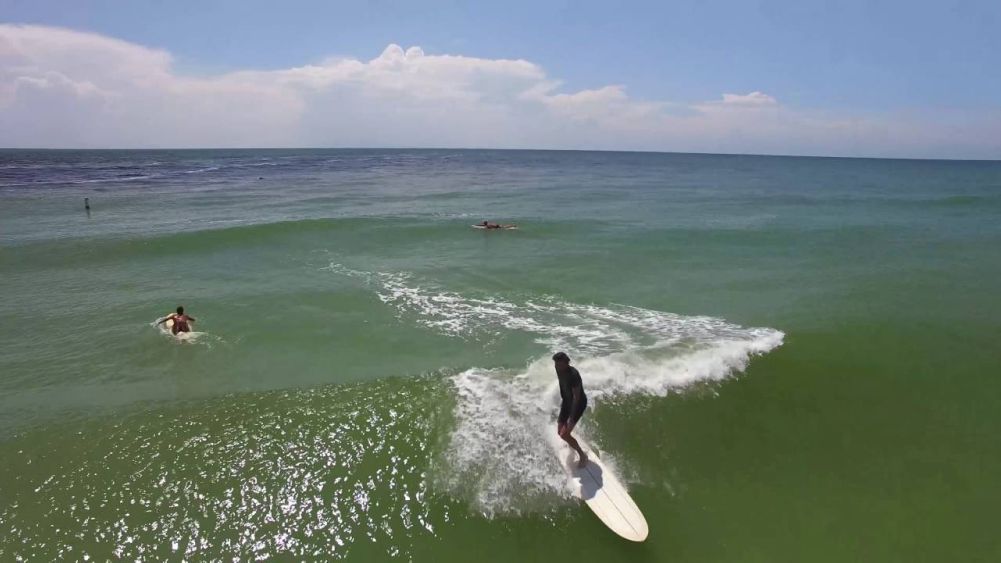
The peaks that form off the north side of the jetty are renowned for their clean, barreling shape and blistering speed on the inside. What’s more, this break can handle just about any swell direction and tends to turn on with size when the winds are blowing from the west.
- Water: Ship channel/Gulf of Mexico
- Swell & Wind: Blocked from direct Gulf swell, smaller wind swell
- Water Temperature: 60s°F to mid 80s°F
- Air Temperature: 60s°F to 90s°F
- Wave Size: 1-3 ft typical
- Crowd Levels: Light
- Best Time to Surf: Year-round with smaller crowds than beaches
- Launch Points: Rocky shoreline near jetty
- Unique Feature: Jetty shapes some waves
- Skills: Intermediate to advanced
- How Long to Get There: 1 hour from Houston
14. San José Island
San José Island, accessible by a 10-minute ferry from Aransas Pass (known as St. Joe’s), is a haven of surfing in Texas when the wind kicks up from the southeast, producing legendary Texan waves.

However, ease of access, jellyfish (including Portuguese man o’ wars), and washed-up detritus can be sources of grievance. For the adventurous, paddle out across the channel at the Aransas Jetties when the waves are head-high and create unforgettable memories. Wavers should not forget to bring the bug spray when coming here.
- Water: Gulf of Mexico
- Swell & Wind: Receives full exposure to Gulf swells, variable winds
- Water Temperature: 60s°F to mid 80s°F
- Air Temperature: 60s°F to 90s°F
- Wave Size: 3-6 ft typical, large swells possible
- Crowd Levels: Light
- Best Time to Surf: Spring and fall for offshore winds
- Access: Ferry service to the island
- Amenities: Primitive camping on an undeveloped island
- Unique Feature: Remote beach break with consistent surf
- Skills: Intermediate to advanced
- How Long to Get There: 4 hours from Houston to ferry launch
15. Waco Surf Pool
With such a variety of waves on offer, the Waco Surf Pool stands as a testament to the best surfing in Texas, all within a controlled and consistent environment. Upon arrival, you’ll be greeted by the sight of green, chest-high waves rifling through an expansive pool for 30 to 60 yards. Organized in three-wave sets, each rolling in every 70 seconds, this wave pool surfing venue guarantees an abundance of waves, with 120 to 160 opportunities per hour to catch the perfect ride.
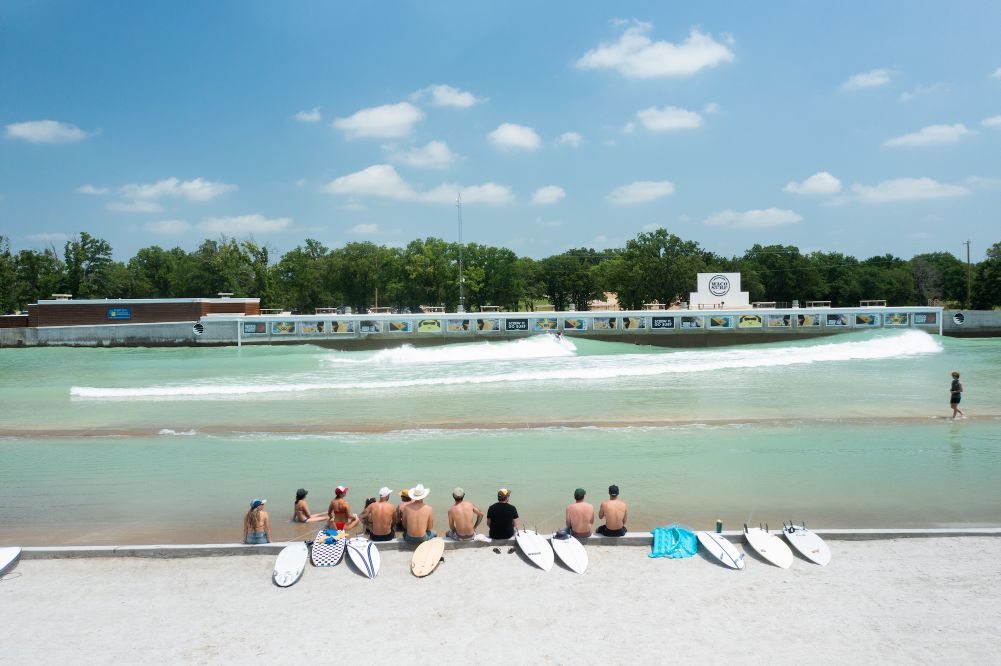
- Water: Freshwater pool
- Swell & Wind: Machine generates waves
- Water Temperature: Mid 70s°F to mid 80s°F
- Air Temperature: 60s°F to 90s°F
- Wave Size: Up to 6 ft
- Crowd Levels: Often crowded
- Best Time to Surf: Check schedule, night sessions available
- Access: Paid admission
- Unique Feature: Inland surfing in man-made pool
- Skills: All levels
- How Long to Get There: 3.5 hours from Houston
Best Times of Year to Surf in Texas
The best times of year for those looking for surfing in Texas largely depend on the specific surf break, but generally fall into two peak seasons:
- July to October: This is the time that many of the prime Gulf Coast spots like Galveston, Surfside, and North Padre Island see their most consistent swells when tropical systems spinning off Mexico can send powerful southerly swells.
- February to April: However, crowds also peak during this warm weather season. Late winter and early spring tend to have fewer people in the water while still offering the potential for large, long period swells originating from the North storms.
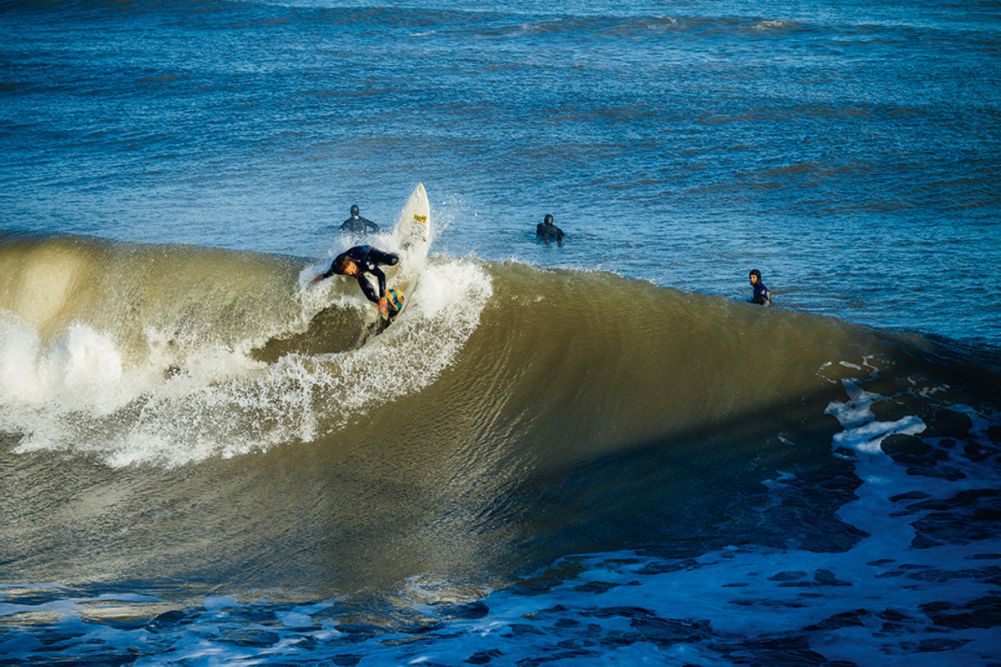
No matter the season, anywhere from South Padre Island down to the state’s southern tip can provide rideable shoulder to overhead conditions on any given day for surfers willing to chase the swells.
Surfing Gear for Texas Waves
When gearing up to surf in Texas, it’s important to consider the local conditions and tailor your equipment accordingly. Here are some recommendations:
- Board Types:
- Shortboards (6’0″ – 6’8″): Great for the often smaller, mushier waves found along most of the Texas coast.
- Funboards/Hybrids (7’0″ – 8’0″): Versatile shapes that work well in the varying Gulf conditions.
- Longboards (9’0″+): Ideal for smaller days and for walking the nose at mellower beach breaks.
- Accessories:
- Booties: The rocky beaches and piers can be hard on feet.
- Gloves: Help prevent wax rashes from the often warm water.
- 3/2 Fullsuit: For the cooler winter months when water temps dip into the 60s.
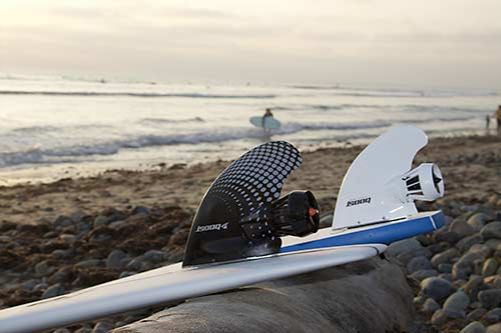
Surfing with a Boost Fin could also be a game-changer for the typical mushy Texas surf. This electric propeller fin provides an extra 20 pounds of thrust to help you catch 3x more waves and maintain speed in sub-optimal conditions. Unlike some other surf propulsion systems, the Boost Fin can quickly hook up to any surfboard in just 5 minutes.
Master the Texas Waves with the Real Boost Fin
Surfing in Texas offers excellent opportunities for beginners to hone their skills, and with the right gear, like the authentic Boost Fin, you’ll be able to make the most of the best beginner-friendly surf spots. The Boost Fin’s impressive thrust and easy control will help you catch more waves and progress rapidly.
Just be sure to only purchase through authorized Boost Surfing channels to guarantee you get the real deal backed by a full warranty. With some preparation and the genuine Boost Fin, the beautiful Texas surf breaks await you to put your skills to the test!
